
Title page of Nathaniel Gould’s account book covering the years 1763 to 1781. (Courtesy, Massachusetts Historical Society; photo, Gavin Ashworth.) The account book has a few entries from the late 1750s that may have been transferred from an earlier book and a few entries that postdate Gould’s death in 1781. The later entries may have been recorded by Gould’s attorney Nathan Dane.

Ca. 1759 credit entry for John Cogswell in Nathaniel Gould’s daybook covering the years 1758 to 1763. (Courtesy, Massachusetts Historical Society; photo, Gavin Ashworth.) At the end of each line Gould wrote “cash” or “goods” to designate the form of payment. The word “goods” could refer to furniture or other commodities sold by Gould, including wood, sugar, fishing line, and wine.

August 24, 1770, debit entry for Clark Gayton Pickman in Nathaniel Gould’s daybook covering the years 1767 to 1784. (Courtesy, Massachusetts Historical Society; photo, Gavin Ashworth.)

Detail of page for November 20–26, 1768, in Nathaniel Gould’s daybook covering the years 1767 to 1784. (Courtesy, Massachusetts Historical Society; photo, Gavin Ashworth.) Most daybook entries are debits. The credit entry for Philemon Parker dated November 20, 1768, indicates that he performed three days’ work for Gould in addition to making a four-foot table and a candlestand. Parker maintained his own shop and was not an employee of Gould.

November 30, 1768, debit entry for Jonathon Very in Nathaniel Gould’s daybook covering the years 1767 to 1784. (Courtesy, Massachusetts Historical Society; photo, Gavin Ashworth.)

Chest of drawers attributed to the shop of Nathaniel Gould, Salem, Massachusetts, 1781. Mahogany with white pine. H. 36 1/8", W. 39 1/16", D. 21 9/16". (Courtesy, Historic New England; photo, Gavin Ashworth.) This chest descended in the family of Charles Chauncey Foster (1785–1875). In 1816 he married Catherine Cabot (1789–1862), the seventh surviving child of Andrew Cabot (1750–1791) and his wife, Lydia (Dodge) (1748–1807). The chest is probably the “bureau table” that Andrew Cabot purchased from Nathaniel Gould on February 24, 1781 (fig. 7). As the relatively unfigured wood in this chest suggests, the mahogany available to Gould during the Revolution was of lesser quality than that available before the war. The third drawer from the top has plane tears on the surface. Gould might have discarded that drawer front if wood had been more available.

February 24, 1784, debit entry for Andrew Cabot in Nathaniel Gould’s daybook covering the years 1767 to 1784. (Courtesy, Massachusetts Historical Society; photo, Gavin Ashworth.) Cabot’s inventory listed two mahogany bureaus (Essex County Probate no. 4431, bk. 360, pp. 499–506), and his will directed that his property be divided equally between his children after his wife’s death (Suffolk County Probate no. 22925, bk. 105, p. 41).

April 15, 1765, debit entry for Joseph Southwick in Nathaniel Gould’s account book covering the years 1763 to 1781. (Courtesy, Massachusetts Historical Society; photo, Gavin Ashworth.)
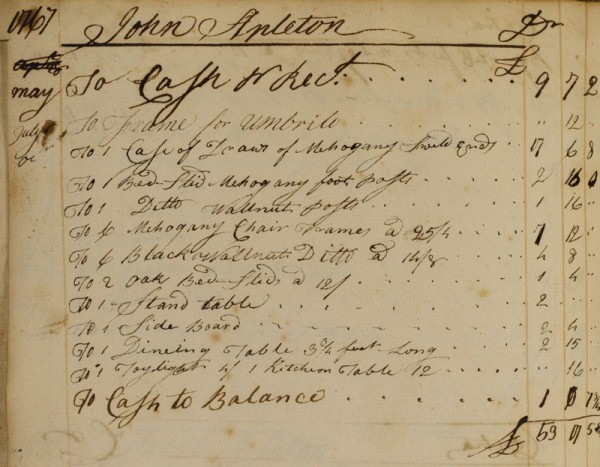
July 1767 debit entry for John Appleton in Nathaniel Gould’s account book covering the years 1763 to 1781. (Courtesy, Massachusetts Historical Society; photo, Gavin Ashworth.)

Chest-on-chest attributed to the shop of Nathaniel Gould, Salem, Massachusetts, 1764–1768. Mahogany with white pine. H. 91", W. 44 1/2", D. 22 7/8". (Courtesy, Nelson-Atkins Museum of Art, Kansas City, Missouri, William Rockhill Nelson Trust; photo, Jamison Miller.) Gould used the term “case of drawers” to identify both cabriole-leg high chests and chest-on-chests.

April 9, 1775, debit entry for Jeremiah Lee in Nathaniel Gould’s daybook covering the years 1767 to 1784. (Courtesy, Massachusetts Historical Society; photo, Gavin Ashworth.)

Debit entries for Jeremiah Lee in Nathaniel Gould’s account book covering the years 1763 to 1781. (Courtesy, Massachusetts Historical Society; photo, Gavin Ashworth.) The August 20, 1772, entry pertains to furniture for Lee’s son Joseph. The April 6, 1775, entry pertains to furniture for Lee’s daughter Mary.

Nathaniel Tracy House, Newburyport, Massachusetts, ca. 1771. (Courtesy, Phillips Library Photograph Collection, Peabody Essex Museum.) The desk-and-bookcase that Jeremiah Lee purchased for his daughter was among the original furnishings of this house.

June 23, 1768, debit entry for Nathaniel Leach in Nathaniel Gould’s daybook covering the years 1767 to 1784. (Courtesy, Massachusetts Historical Society; photo, Gavin Ashworth.) Gould purchased two desks from Philemon Parker and sold one to Leach. The cedar primary wood of Leach’s desk, crating charges recorded by Gould, and his patron’s profession as a ship captain suggest that this desk was intended for export. Gould charged £4 for standard cedar and cherry desks and £4.13.4 for slightly more elaborate cedar examples.

Desk-and-bookcase attributed to the shop of Nathaniel Gould, Salem, Massachusetts, ca. 1775. Mahogany and white pine. H. 105", W. 42", D. 22". (Courtesy, Metropolitan Museum of Art, gift of Mrs. J. Russell Sage; photo, Gavin Ashworth, Image © Metropolitan Museum of Art.) The door panels are book-matched and have prominent stripe figure like the plank used for the fallboard.

Detail of the inscription “Nath Gould not his work” on the desk-and-bookcase illustrated in fig. 15. (Photo, Gavin Ashworth.)
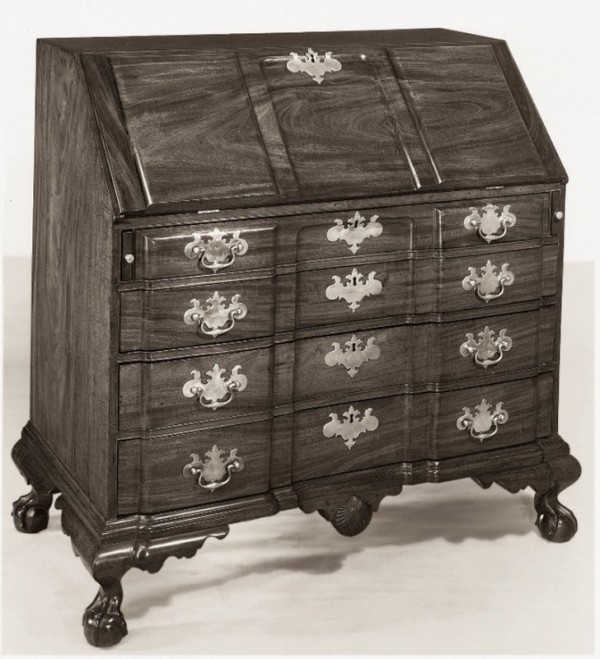
Desk attributed to the shop of Nathaniel Gould, Salem, Massachusetts, 1758–1780. (Courtesy, Bernard & S. Dean Levy.) Although this desk is marked “H x RUST,” its stylistic and structural features suggest that it originated in Nathaniel Gould’s shop. The construction differs from that of the Rust desk illustrated in fig. 19.
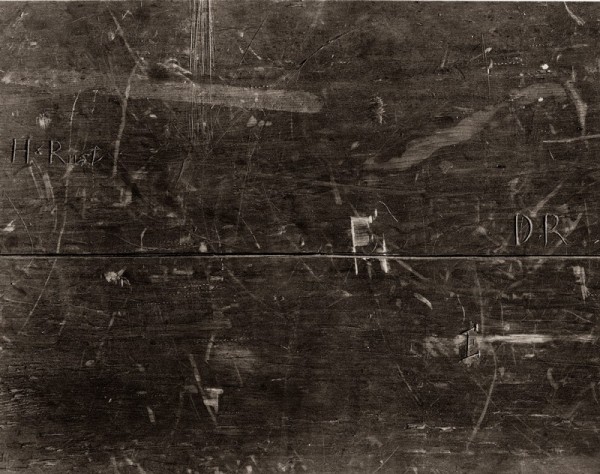
Detail of the mark on the desk illustrated in fig. 17.

Henry Rust, desk, Boston, Massachusetts, 1770. Mahogany with white pine. H. 42", W. 37", D. 18 1/2". (Courtesy, Metropolitan Museum of Art, gift of the family of Edward and Kaye Scheider [2007.158 a-e]; photo, Gavin Ashworth, Image © Metropolitan Museum of Art.) Rust was a competent cabinetmaker, but his work falls short of that performed in Nathaniel Gould’s shop.

Detail of the inscription on the desk illustrated in fig. 19. (Photo, Gavin Ashworth.)

Detail showing additional writing and drawing on the desk illustrated in fig. 19. (Photo, Gavin Ashworth.)

Detail showing the dovetailing at the back of a large drawer from the desk illustrated in fig. 19. (Photo, Gavin Ashworth.)

Detail showing the dovetailing at the back of a large drawer from the desk-and-bookcase illustrated in fig. 15. (Photo, Gavin Ashworth.)

Invoice from Nathaniel Gould to Richard Derby, Salem, Massachusetts, November 21, 1763. (Courtesy, Peabody Essex Museum.) The invoice is in the Derby Papers, Miscellaneous Receipts, MSS 37, box 15, folder 5.

Detail of the right front foot of the chest of drawers illustrated in fig. 6. (Photo, Gavin Ashworth.)
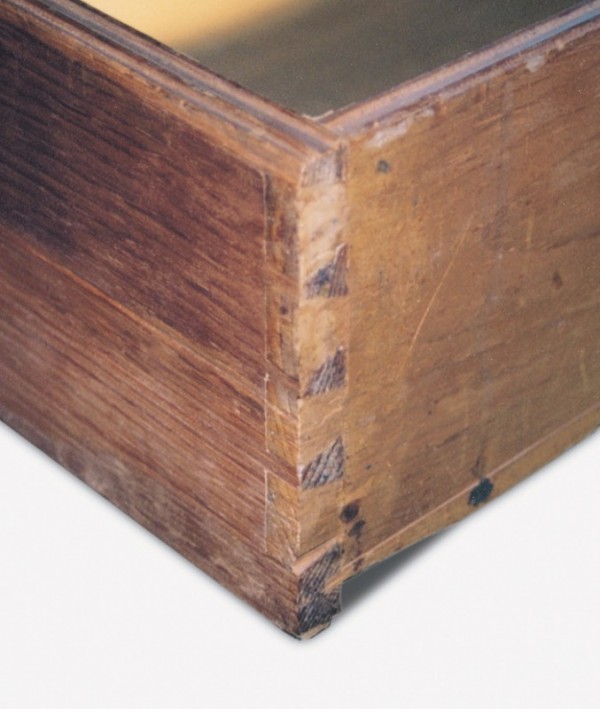
Detail showing the dovetailing and beading of a drawer from the chest-on-chest illustrated in fig. 10. (Photo, Kemble Widmer.)

Detail of the lock on the lid of the desk-and-bookcase illustrated in fig. 30. (Photo, Gavin Ashworth.)

Detail of the writing compartment of the desk-and-bookcase illustrated in fig. 15. (Photo, Gavin Ashworth.) Gould typically used clock hinges for prospect doors.

Detail of the number “7” on the back of the third drawer from the chest of drawers illustrated in fig. 6. (Photo, Gavin Ashworth.) The numbers denoted drawer height.

Desk-and-bookcase attributed to the shop of Nathaniel Gould, Salem, Massachusetts, 1765–1781. Mahogany with white pine. H. 96 1/8", W. 44 1/8", D. 22 3/4". (Courtesy, C. L. Prickett Antiques; photo, Gavin Ashworth.)

Cabot family tree showing purchases of desk-and-bookcases and lines of descent. (Genealogy by Joyce King; artwork, Wynne Patterson.)

Composite detail showing the fallboards of the desk-and-bookcases illustrated in figs. 15 (top) and 30 (bottom). (Photo, Gavin Ashworth.)
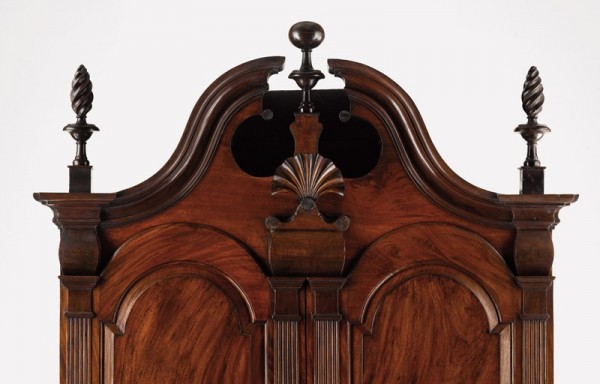
Detail showing the door arches and pediment of the desk-and-bookcase illustrated in fig. 30. (Photo, Gavin Ashworth.)

Details of the drop on the chest of drawers illustrated in fig. 6. (Photo, Gavin Ashworth.) Compass points on drops associated with Gould’s shop and variations in the size and shape of standard components indicate that he and his workmen rarely used patterns.

Detail of the dovetailing on the lower drawer of the chest of drawers illustrated in fig. 6. (Photo, Gavin Ashworth.)
